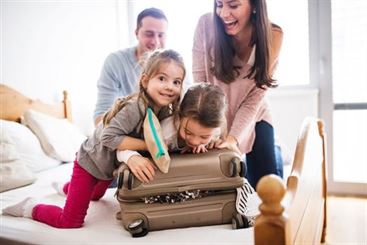5 Things I Wish I’d Known as a Cruise Rookie

Your suitcase is by the front door, your brand new pair of flip-flops are on your feet, and you’ve got your vacation playlist blasting through your Bluetooth speaker. You’re officially ready for your first cruise tomorrow morning.
Suddenly you notice all those house plants sunning in the kitchen window, and realize you don’t have anyone to water them. Speaking of which, who will water and feed the dog while you’re gone? And wait a minute, did you remember the sunscreen? What about your passport?
As exciting as going on your first cruise can be, there are small but important details that are easy for first-time cruisers to overlook.
Depending on the length of your cruise, it’s important to have someone look after your home and lawn, check in on your pets, gather your mail, and more. And even though you may have covered most of the essentials while packing (you remembered underwear, right?), there are a few things you may not realize you’ll want onboard (or want to leave behind).
As a new cruiser, you may not know what to expect once you arrive at the pier. For example, it’s critical to be there at least two hours early with all necessary documents. And once onboard, you likely won’t receive your luggage until later in the evening, so you’ll want to be sure to have a carry-on with anything you’ll need for your first day onboard.
From what to do before you leave the house and arriving at the pier to disembarkation, we’ve put together 5 things every cruise rookie should know so you can be fully prepared for fun during your first cruise.
1. Before You Leave the House
When traveling internationally for extended periods of time, there are several things you’ll want to do to make sure your house, finances, and reservation are in order.
- Make sure you have someone to care for your pets, flowers, or garden; take out your trash and recycling; bring in your mail; mow the lawn or shovel the drive, etc.
- If traveling for more than a week, it may be a good idea to turn off your water (unless it’s summer and you need your sprinklers to run), and turn your air conditioner or heater to a lower-energy setting.
- Make sure your cell phone can make international calls.
- Notify your bank that you will be traveling to whichever country you’re going to — otherwise they may see any spending on your credit card as fraudulent and put a hold on your card.
- If traveling abroad, enroll in STEP (Smart Traveler Enrollment Program). This program allows the U.S. Embassy to stay in touch and provide important information about safety conditions in your destination country, natural disasters, civil unrest, or if someone back home has a family emergency.
- Be sure to keep small bills on hand to pay for porters and tips throughout the week.
- Many cruise lines have special apps you can download on your smartphone that help answer questions, provide information about activities, events, excursions, and more.
- Your travel agent at CloudBlue Travel will contact you to remind you when it’s time to check in online. You will need to provide passport info, travel info, and emergency contact information. Some cruise lines will also ask you to upload a picture of yourself for identification.
2. What to Pack or Leave Behind
Beyond the obvious things like all your important documents, casual clothes, formal wear, toiletries, and all electronics and chargers, there are other details that first-time cruisers may overlook. Below are a few lesser-known details about what to pack (and what to leave at home).
- Don’t forget sunscreen. From walking around on deck to lounging by the pool to onshore excursions, you’ll need protection from the sun. Sunscreen is available onboard, but can be pricey.
- Bring any medications you need. It’s smart to bring a small First Aid Kit that includes things like Band-Aids, Tylenol, antacids, ear drops, eye drops, and any other things you might need.
- All staterooms will have a hair dryer.
- You are not allowed to bring an iron of any kind – including travel irons.
- Laundry services are available for a small fee that your cabin attendant can arrange for you.
- If you forget any of the essentials — toiletries, diapers, Tylenol, etc. — there is a small general store onboard where you can purchase most of these items.
- Beach towels are provided, so no need to bring them from home.
- You can usually bring up to 2 bottles of wine onboard. You may not bring any other liquor on board. Cruising staff will hold it for when you disembark.
- Cabins can be very dark when the lights are off. If you have kids or just want an easier time getting around at night, it may be wise to bring a nightlight.
- The walls and doors of your cabin are metal, and therefore magnetic. You can bring magnetic clips or magnets to hang documents like schedules, tickets, notes, etc.
- Many cruises used to commonly have “formal nights” where guests would wear very dressy clothes. Most have done away with this event, and now ask that guests wear “smart casual”, chic”, or “country club casual” during the evening dining time. Think khakis, button-up dress shirts, slacks, nice dresses, and blouses.
If you have a disability, you may be wondering what types of mobility devices you can bring onboard, where you can store them, and more. Find out more about cruising options for travelers of all different abilities »
3. The Day of Your Cruise
The day is finally here! Before you let the excitement get the best of you, make sure you have the following essentials taken care of before you head to the ship.
Heading to the Pier
- Put all passports and cruise documents in your carry-on bag. These must be with you when you board.
- Per Homeland Security regulations, you must be at the pier no later than 2 hours before your scheduled sail away.
- Make sure your luggage is tagged with your name, address, and phone number.
- Pack a carry-on bag with things you might need for the first afternoon, such as bathing suits, a change of clothes, and medication.
- You will be able to get into your stateroom shorty after going aboard, but your luggage may not be delivered until later that evening.
Arriving at the Pier
- Make sure all of your luggage has a tag with your cabin number on it.
- If you forget your luggage tags, or you don’t have any, just show your boarding pass to the porter and he/she will affix a tag for you.
- When you arrive, you will turn your luggage over to a porter. It’s customary to tip the porter around $2 per bag.
- Remember to keep a carry-on bag with things you’ll need for the afternoon.
- Get in line to meet with a check-in representative. Even if it’s long, the line usually moves quickly.
- You’ll need to present your passports, guest tickets, and a credit card onto which all of your expenses will be charged.
- Each family member or travel partner will receive a “charge card” which you’ll use for all purchases on the ship. These cards are also used as a room key and identification when getting off or on the ship.
- It’s very important to keep track of your charge card — you can’t get off the ship at any port without showing your cards, and you can’t get back on the ship without them, either.
4. Getting Onboard
You’re finally onboard! But before the fun begins, you’ll want to make sure that all your reservation details for the trip look correct. That includes drink and dining packages, onboard events, and onshore excursions. Not to mention making sure you know what to do in case of an emergency.
- If you have not purchased a drink package or a dining package and wish to do so, you can do so once onboard.
- Before the ship leaves port, you’ll be required to attend a “muster drill.” This is mandatory, so you and your family or travel partner must attend. The location of your drill station will be on your cruise card. It may be a spot outside on the deck, or it might be in the theater or dining room.
- Your luggage might not be delivered to your room until 5pm or so (again why it’s important to have that afternoon carry-on).
- Most staterooms are equipped with plenty of storage, including hidden shelves and drawers throughout your cabin. Don’t be afraid to ask a cruise attendant if you have questions about additional storage options.
- There should be a safe in your room where you can securely store valuables and other belongings. It may be located in a cabinet or inside your closet.
- Any tickets for shore excursions you have pre-booked will be in your cabin when you arrive. The meeting time and place will be on the tickets.
- You’ll probably meet your room steward when your bags are delivered. They will clean your cabin, make your bed, and turn down your bed in the evening. If you have any special requests for the cruise, let them know and they’ll do their best to accommodate you.
5. Disembarkation
No one wants to think about the last day of vacation. However, you can make your travel home quicker and easier by knowing how to prepare for disembarkation.
- A few nights before your last night, you’ll be given written instructions and luggage tags with a specific number or color. This designates the time at which you can leave the ship. The color or number is assigned according to the time of your travel, and the time that your luggage will be available in the terminal.
- The night before you leave the ship, pack all of your belongings except what you might need in the morning. Be sure to leave out an outfit that you can wear off of the ship.
- Don’t forget to remove all your belongings from the safe.
- Access your onboard account to make sure all charges are valid. If there are any discrepancies, visit guest relations on the night before disembarkation. It’s difficult to dispute a charge once you leave the ship, so it’s important to take care of this before disembarkation.
- The morning of disembarkation, you’ll need to go to the public area designated on your colored luggage tag, and wait to be called to leave the ship.
- Once you’re in the luggage terminal, head to the numbered or colored area where your luggage will be. A porter can help you find your luggage, and stay with you through the immigration process if necessary. They can even help you find a taxi stand or other forms of transportation. Depending on how much time the porter takes to assist you, it’s customary to tip between $10-$15.
- A few days after you return home, you’ll receive a survey from the cruise line. Be sure to mention what you loved, and what could be improved. Your feedback can make a difference for your next cruise!
At CloudBlue Travel, we can help with every step of the cruising process. From booking the perfect trip to knowing what to pack to arranging special dinner plans onboard, leave it to us to do the heavy lifting so you can sit back and relax. Because that’s how preparing for your cruise vacation should be — as sweet and satisfying as a daiquiri (or two…or five). Live it up, we won’t judge you.
Contact us today to get answers to any of your cruising questions »
Get Travel Deals Today!


